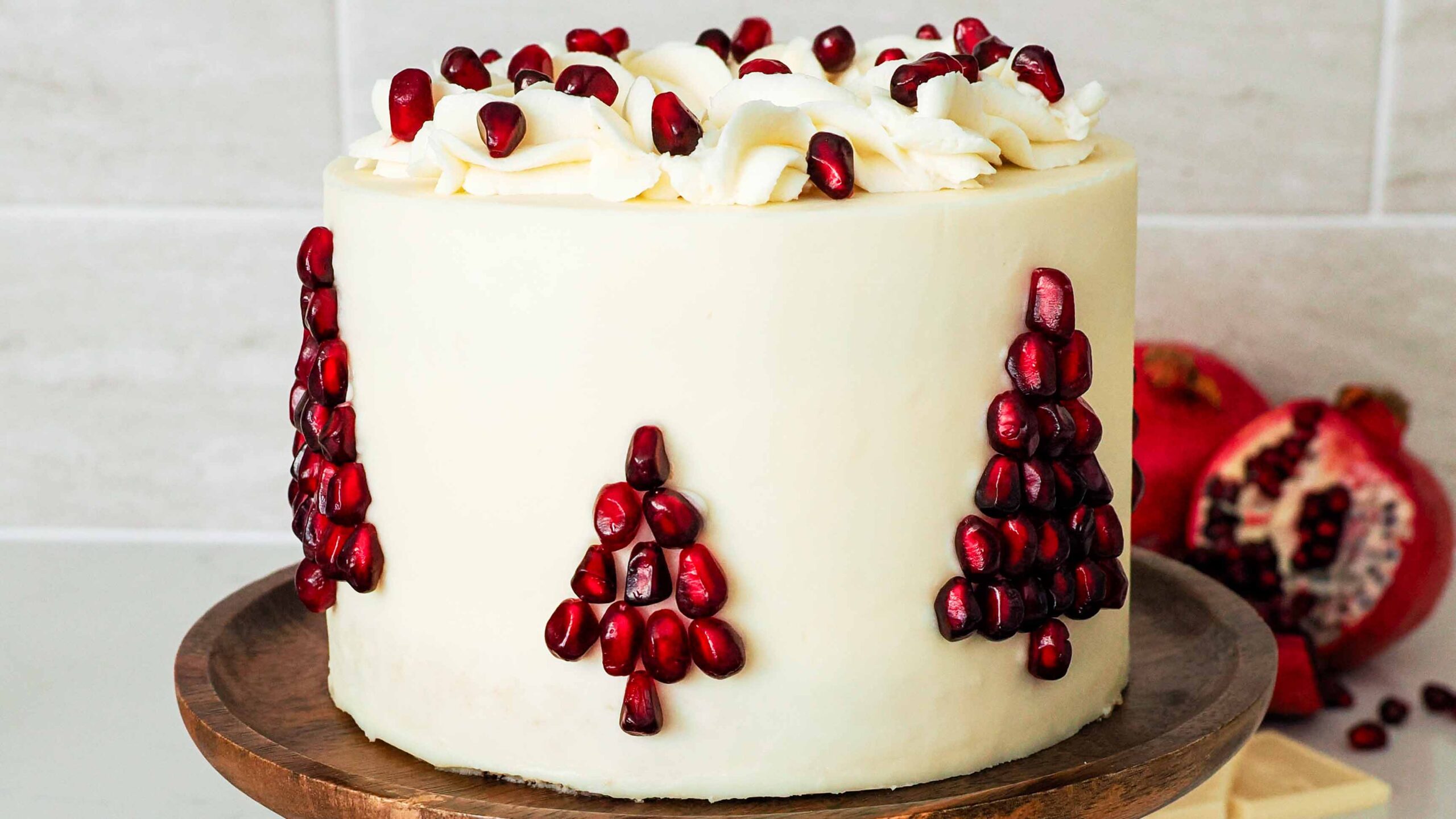A small Christmas cake that makes a big impression, 6″ white chocolate pomegranate layer cake is filled with pomegranate jelly and frosted with an easy white chocolate buttercream. Light and fluffy white cake is perfectly balanced with tart pomegranate jam and sweet white chocolate buttercream. When assembled and decorated, this cake is a perfect dessert to bring to Christmas parties.
Decorate the sides of the cake with pomegranate arils by arranging them into the shape of a Christmas tree for an easy and fuss-free way to decorate cakes at Christmas time. Or, add iced chocolate gingerbread cookies on the side to add a kick of ginger and warm spices. Warm spices and pomegranate pair beautifully together!
You can also watch short videos on how to make pomegranate cake, how to assemble pomegranate cake, and how to make pomegranate Christmas trees on my YouTube channel.
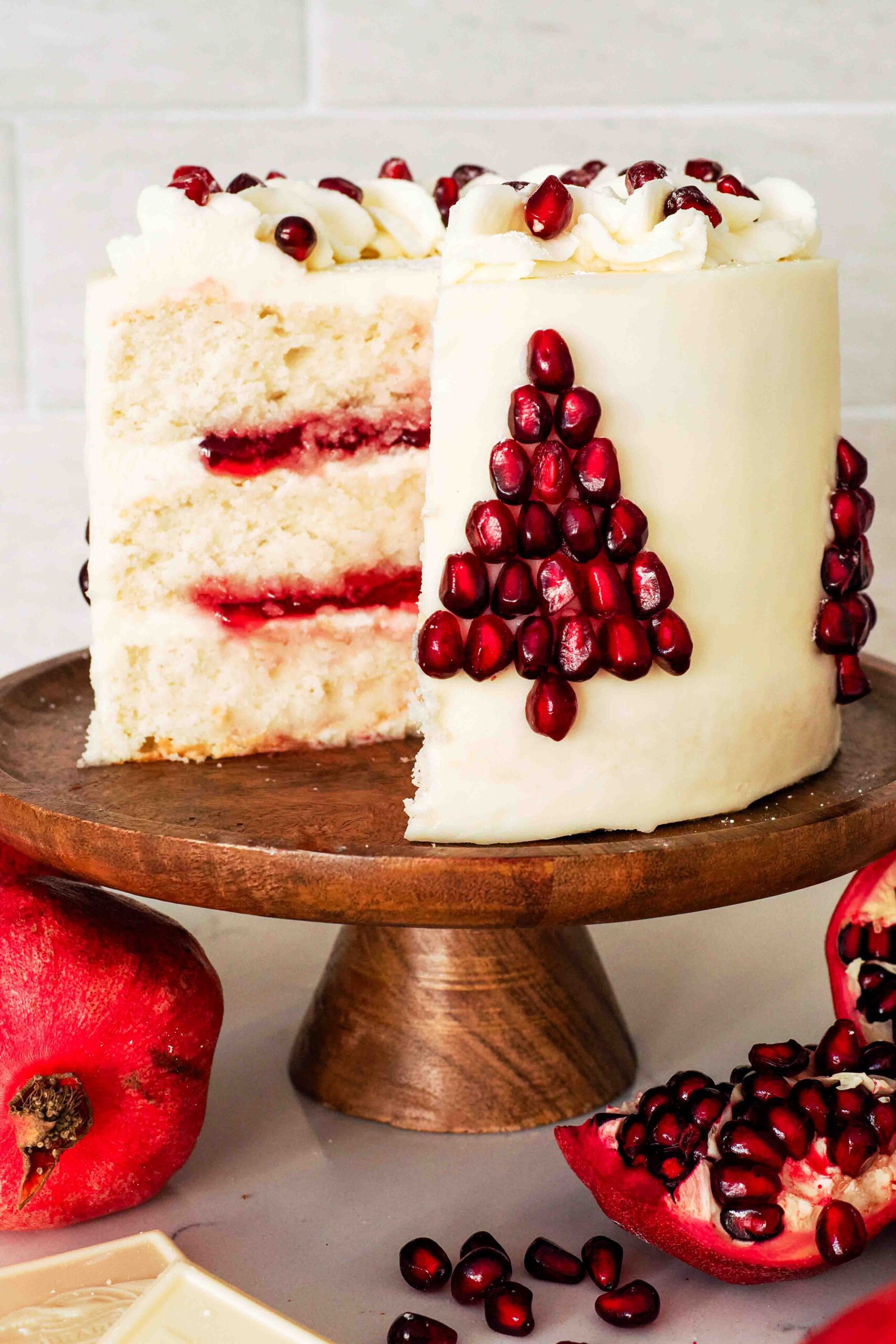
This post contains affiliate links. If you click through and make a purchase, I may receive a small commission at no cost to you. Thank you for helping to support The Floral Apron!
Ingredients for White Chocolate Pomegranate Cake
I developed the cake and buttercream recipes specifically for this pomegranate layer cake, so the sweet white chocolate and tart pomegranate are balanced nicely with a light, white cake. There’s nothing fussy about the ingredients: Most of them are fridge and pantry staples, apart from the pomegranates (which are only available for a few months out of the year).
Ingredients for the White Cake
- Egg whites. When whipped, the egg whites make the cake light and fluffy. Eggs in the shell work best, as pasteurized egg whites may not whip.
- Granulated sugar. Granulated sugar contributes to a moist cake and strengthens the meringue.
- Butter. Use unsalted or salted butter depending on your preference.
- All purpose flour. Plain flour gives the cake structure. You may substitute 1:1 gluten-free flour, but I haven’t tested it.
- Baking powder. Necessary for a good rise, or else your cake will come out flat.
- Salt. Just a pinch helps to enhance all the flavors.
- Neutral oil. A mildly flavored oil like canola, vegetable, or even grapeseed adds back some of the fat we’re missing from not using the egg yolks.
- Vanilla extract. You may also use vanilla bean paste.
- Milk. Full-fat or whole milk works best with that extra bit of fat, but 2% also works well.
Ingredients for the Buttercream, Filling, and Decoration
- White chocolate. Use a high quality white chocolate, like Ghirardelli, for best results.
- Heavy cream. Just a splash makes the white chocolate buttercream smooth and voluminous.
- Unsalted butter. The bulk of the buttercream, use unsalted butter to prevent it from being too salty.
- Powdered sugar. This thickens the buttercream
- Pomegranate jelly. The star of this pomegranate cake, make the jelly at least one day in advance to ensure it has enough time to set and thicken.
- Pomegranate arils (seeds). Fresh pomegranates are generally available in stores from October to January. Use as decor on the sides and top of the cake. You can also add a few arils to the inside layers, if you like!
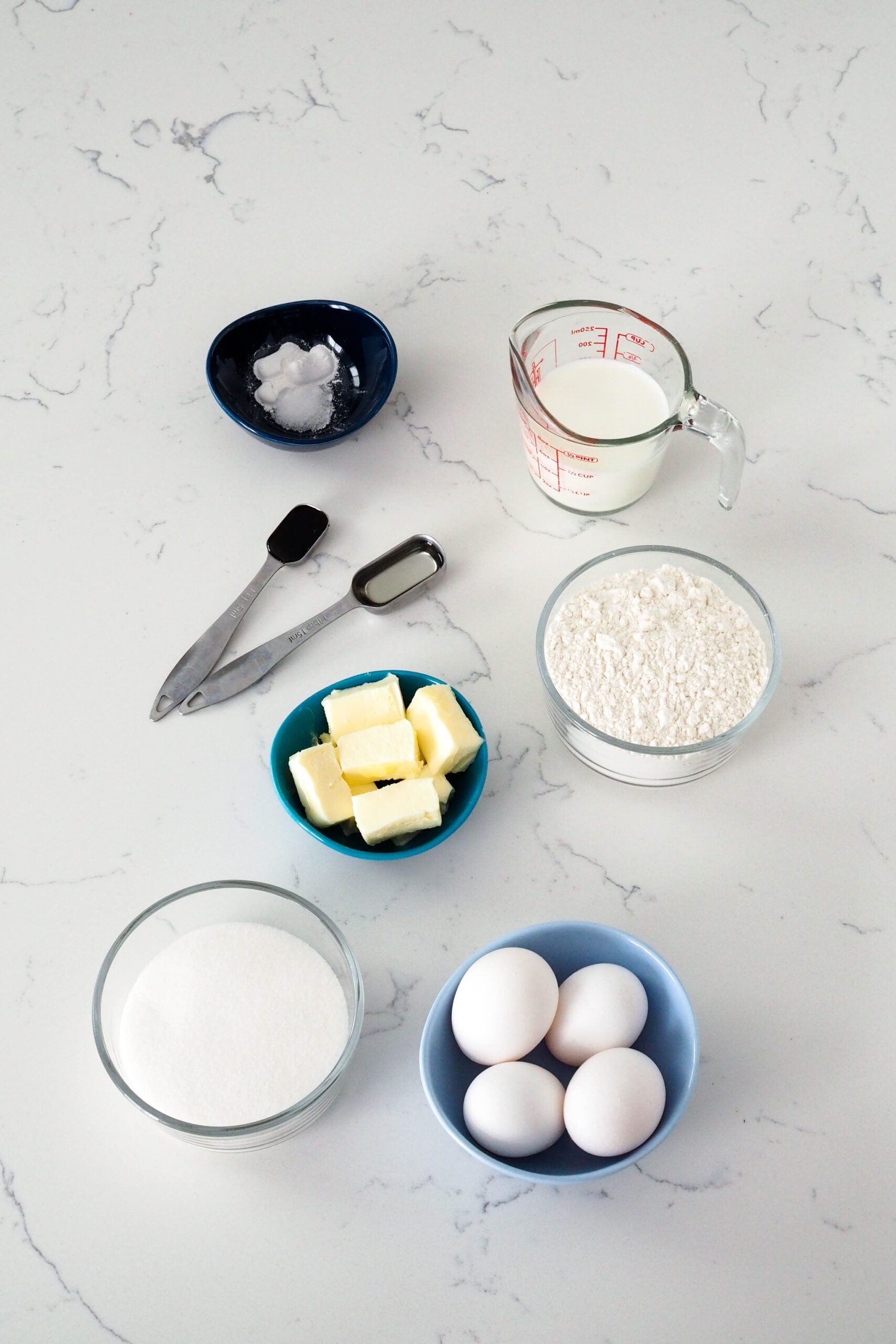
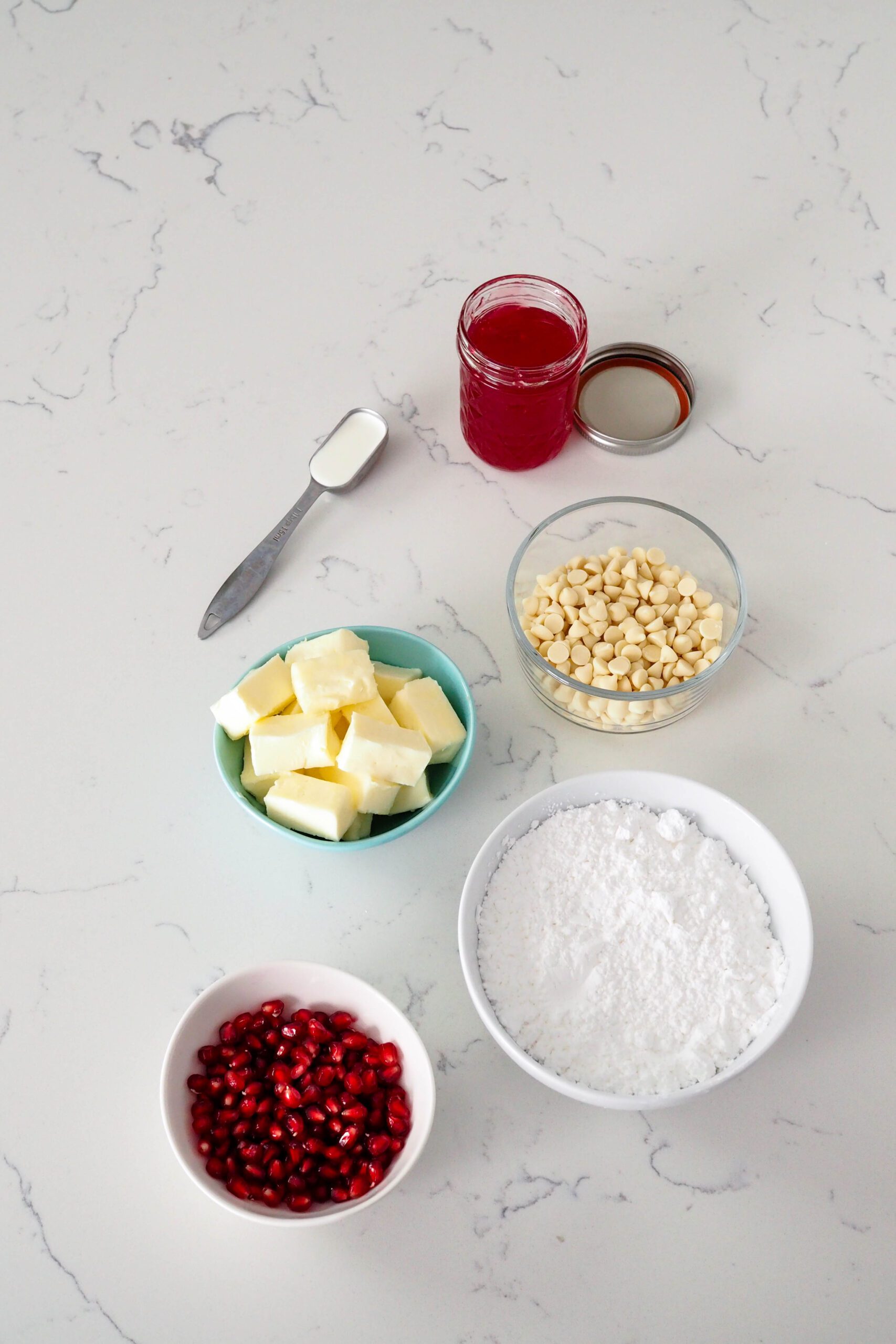
Quick Tips to Make White Cake
I combined two cake-making methods into one recipe for the lightest and fluffiest white cake I’ve ever tasted. First, whip the egg whites into a meringue. Then, reverse cream the dry ingredients and beat in the liquid ingredients. Finish by folding in the meringue. This method requires one extra bowl due to whipping the meringue, but the difference it makes is more than worth an extra minute at the sink.
Mix Up the Cake Batter
Key things to note: Whip the egg whites with about half of the sugar. This will stabilize the meringue and prevent it from deflating during reverse creaming. I recommend using a stand mixer or hand mixer, as whipping egg whites to soft peaks can take a long time without one.
Transfer the meringue to another bowl, then wipe out your mixing bowl to reverse cream the dry ingredients. Or, if you like, you can use a clean bowl.
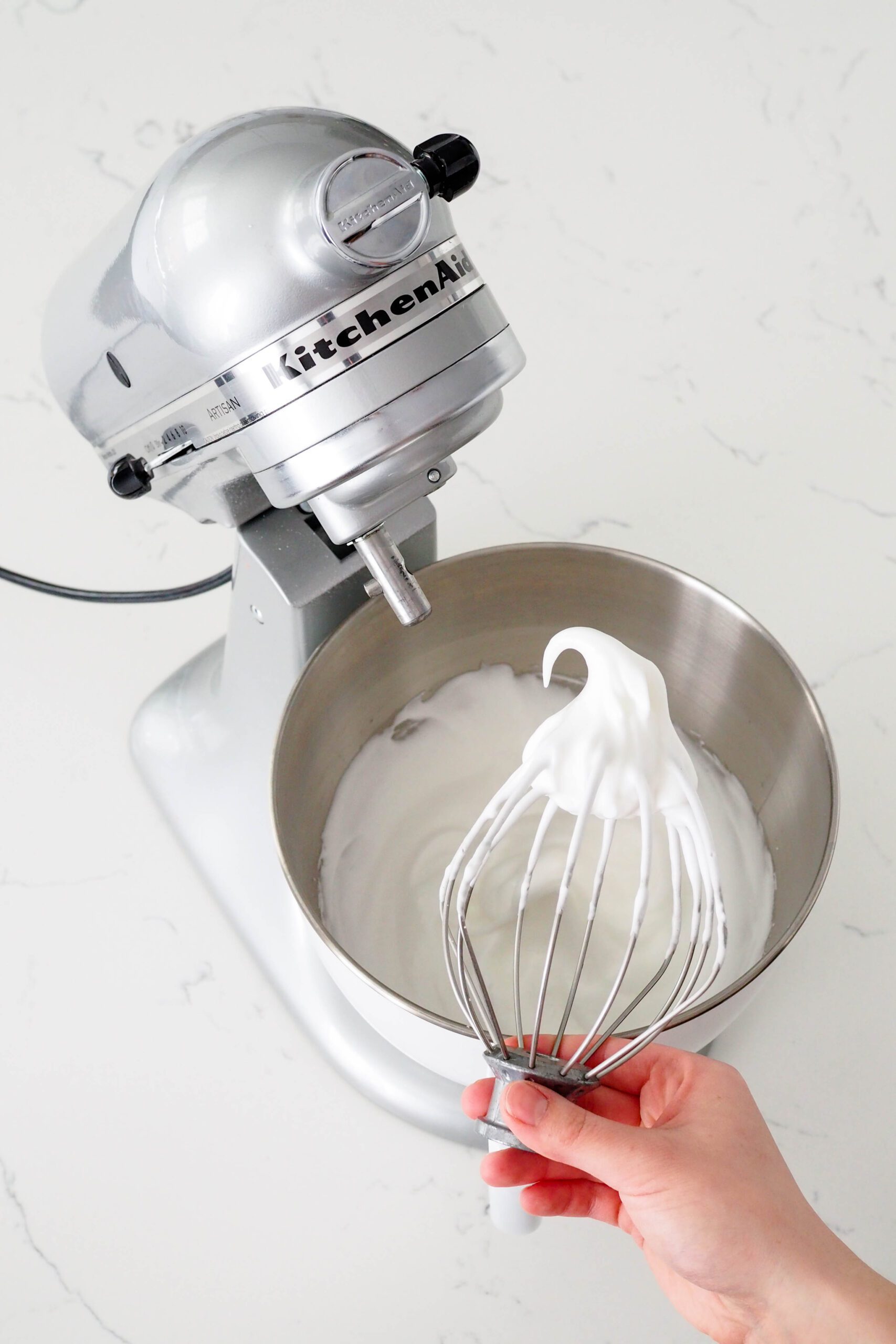
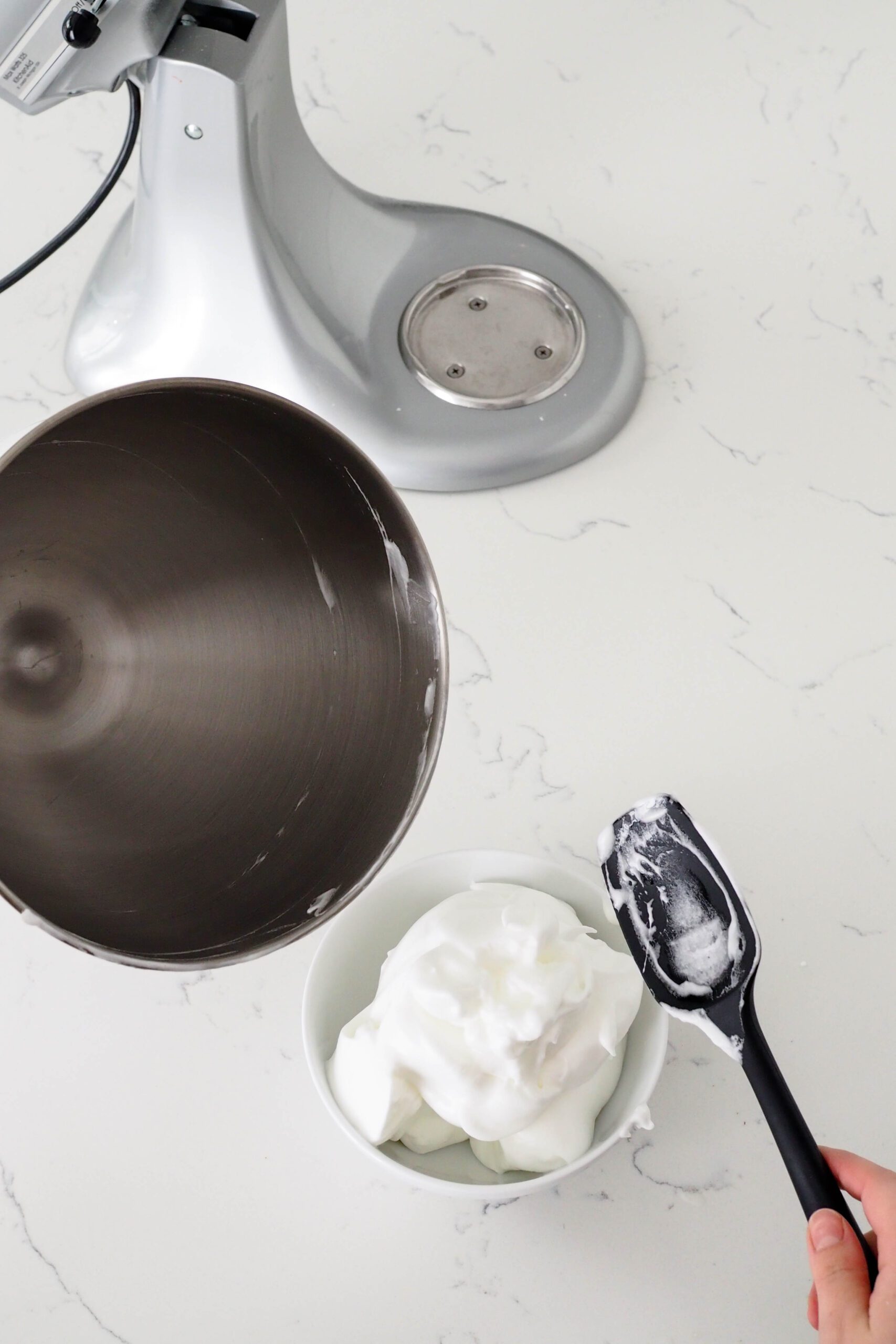
Reverse creaming combines all the dry ingredients in the cake with the fat before adding in any liquid. The flour and other dry ingredients get coated in fat, which helps prevent gluten development when liquid is added. This results in a moist cake with a tender crumb that melts in your mouth.
Pour the milk, canola oil, and vanilla extract into the mixer while on low, then beat for a minute until the batter is smooth. Scrape down the sides and bottom of the bowl to ensure there aren’t any sneaky chunks hiding out.
Then, fold in the meringue.
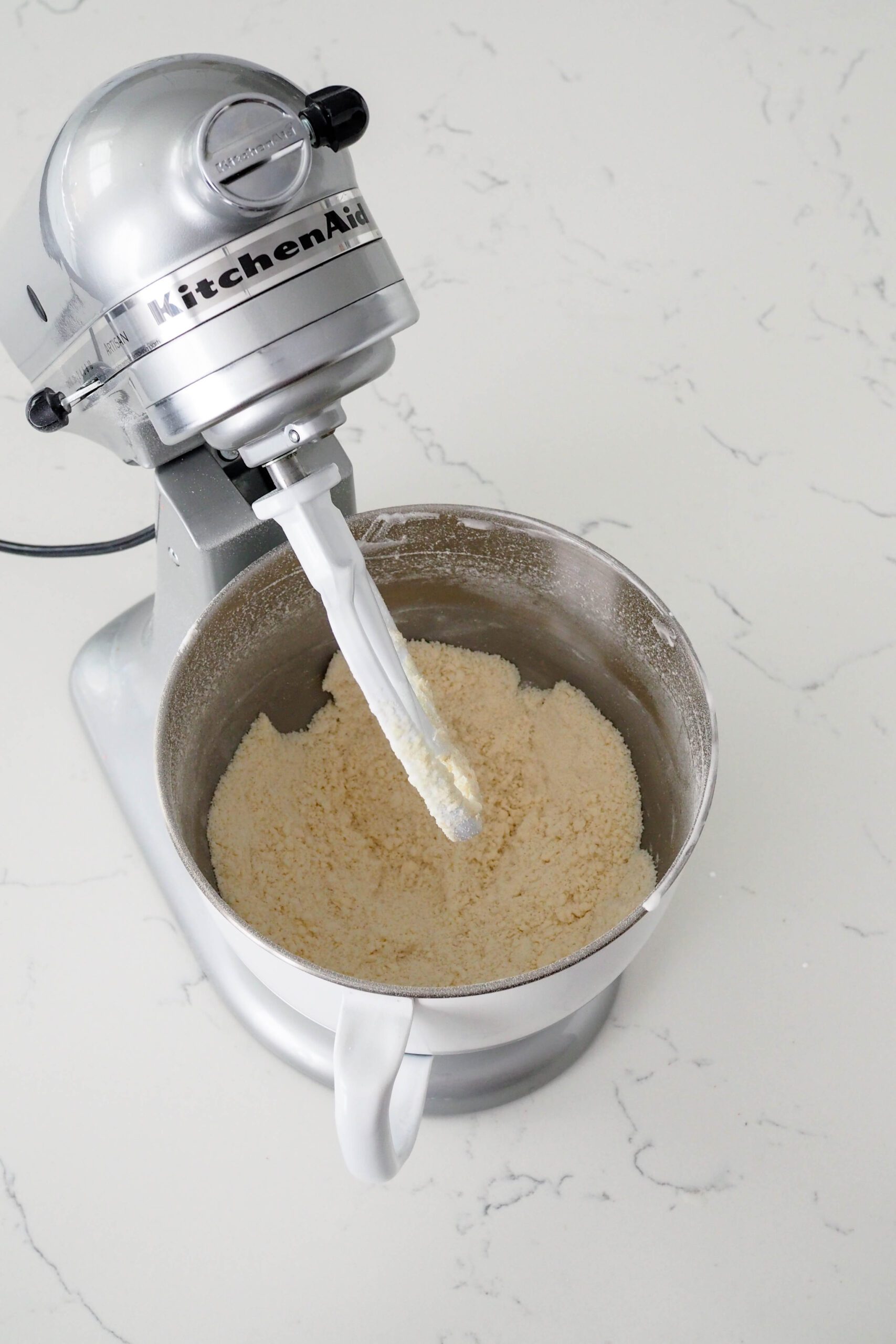
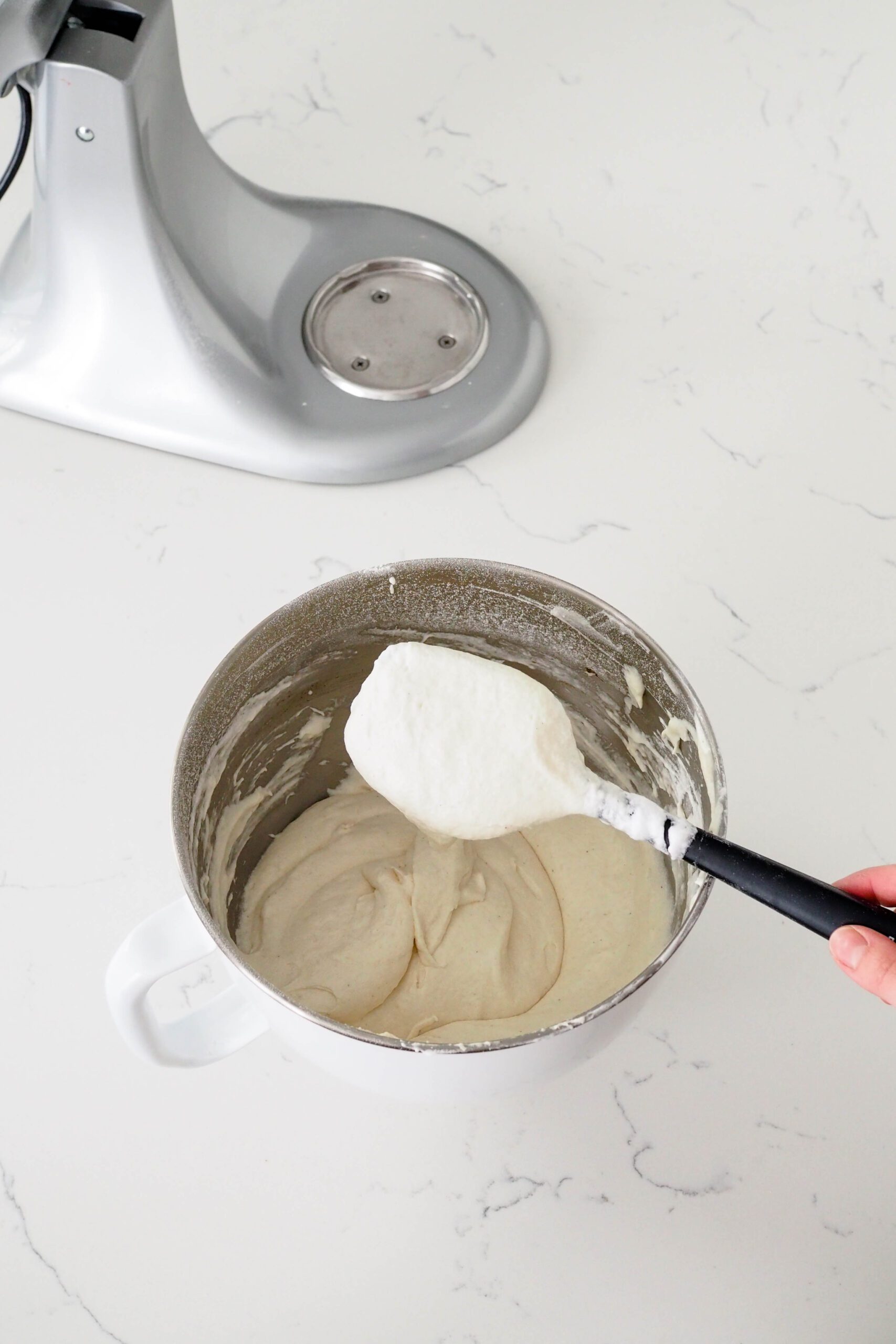
Bake the Cakes
Divide the cake batter into three 6″ cake pans. The easiest way to do this is to weigh the batter in each pan as you pour it in. This will ensure even cake layers that all finish baking at the same time.
Bake for about 20 minutes at 350°F/175°C. These cakes are small, so they don’t take long to bake. If you’re using dark-colored pans, which absorb more heat, check on your cakes five minutes early.
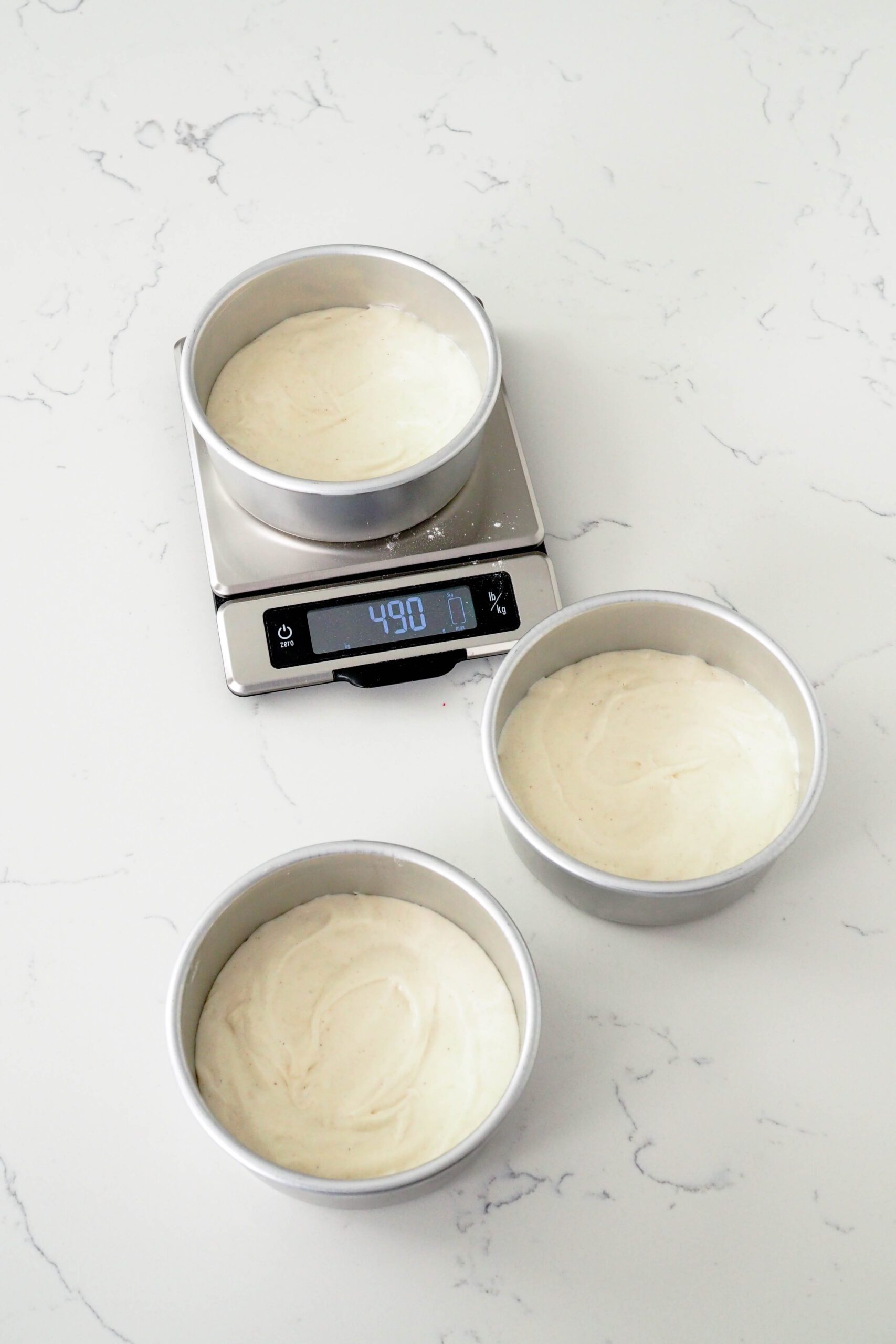
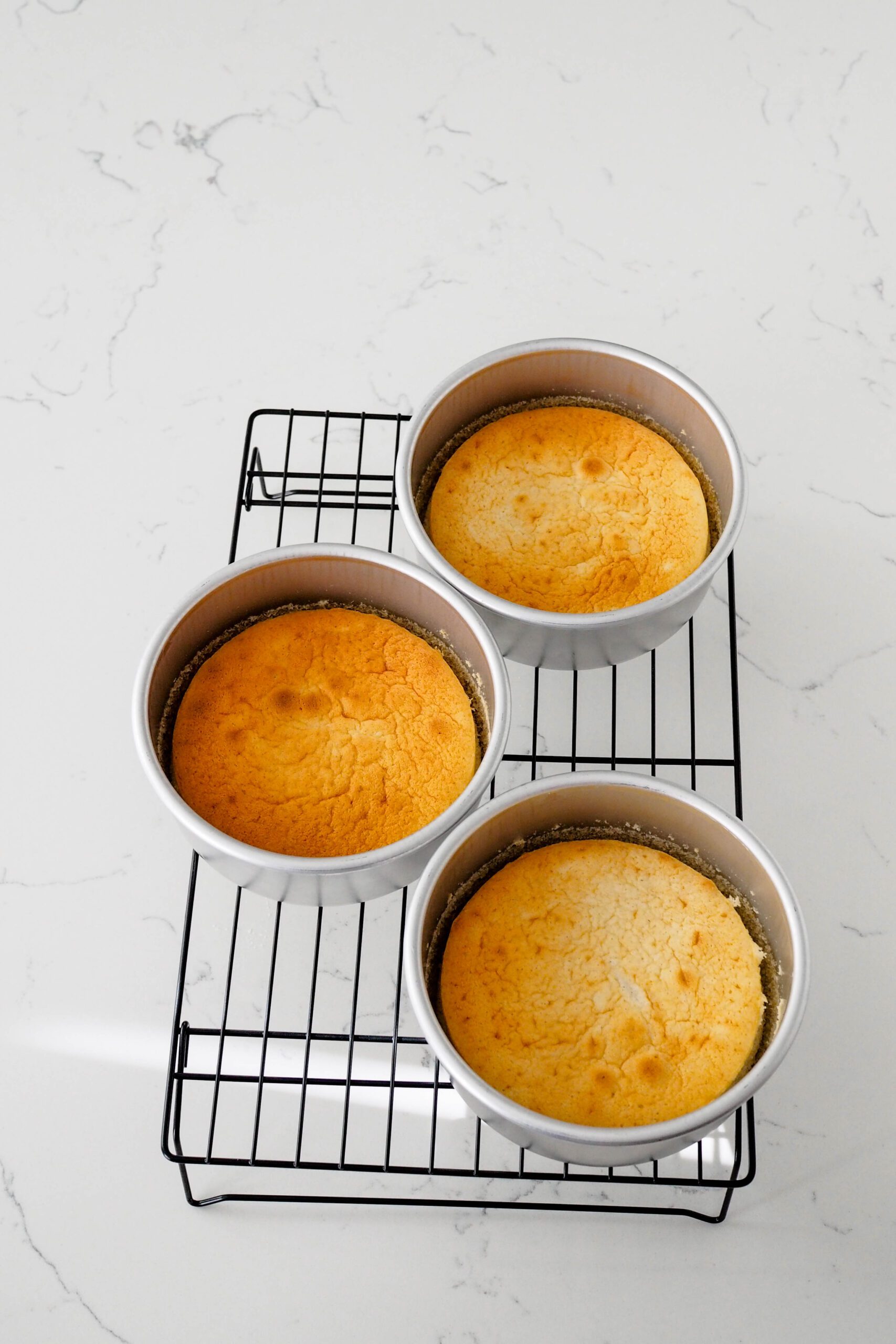
Quick Tips to Make White Chocolate Buttercream
White chocolate buttercream is more particular than traditional American buttercream but not nearly as fussy as French buttercream. I had a couple batches turn out poorly during development, so I can share what not to do when making this buttercream with white chocolate!
Fully Melt the White Chocolate
It’s easy to burn white chocolate because it has a lower melting point than milk and dark chocolate. When melting it over the stove or in the microwave, stir it frequently to even out any hot spots.
You’ll also want to make sure you melt the chocolate until it is completely smooth. Any pieces of chocolate that aren’t melted now will remain in the buttercream, and that will make for a lumpy buttercream (and potentially clog your piping tip).
Fully Cool the White Chocolate
The white chocolate needs to cool down before you add it to the buttercream. Otherwise, it’s just going to melt the butter and make a huge mess.
When the bowl of melted chocolate is only slightly warm to the touch, give the white chocolate a final stir before adding it to the buttercream.
If your white chocolate begins to harden, reheat it for a few seconds and stir to get the lumps out. Any lumps in the white chocolate will transfer to the buttercream. And no one wants a lumpy buttercream!
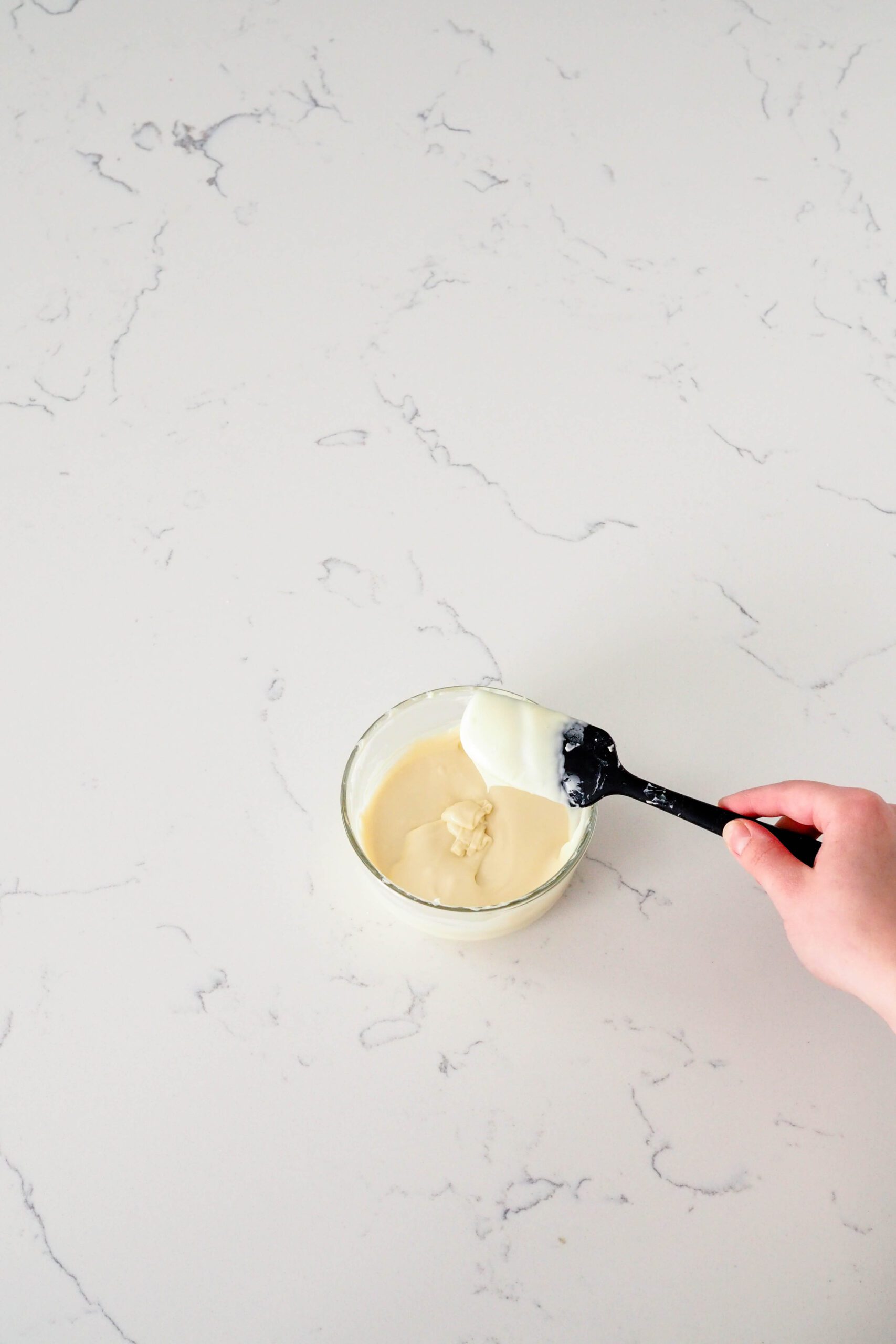
Pour the White Chocolate into a Well in the Buttercream
Sometimes, melted chocolate can get on the sides of the metal mixer bowl and harden prematurely. To prevent lumps from forming this way, you’ll want to prevent the chocolate from touching the sides of the mixer bowl too early.
Make a small well in the center of the buttercream, and pour the white chocolate into it. Then, beat on low until the chocolate looks fully combined.
Once the white chocolate is incorporated, increase the speed to medium and beat for 2-3 minutes until light and fluffy.

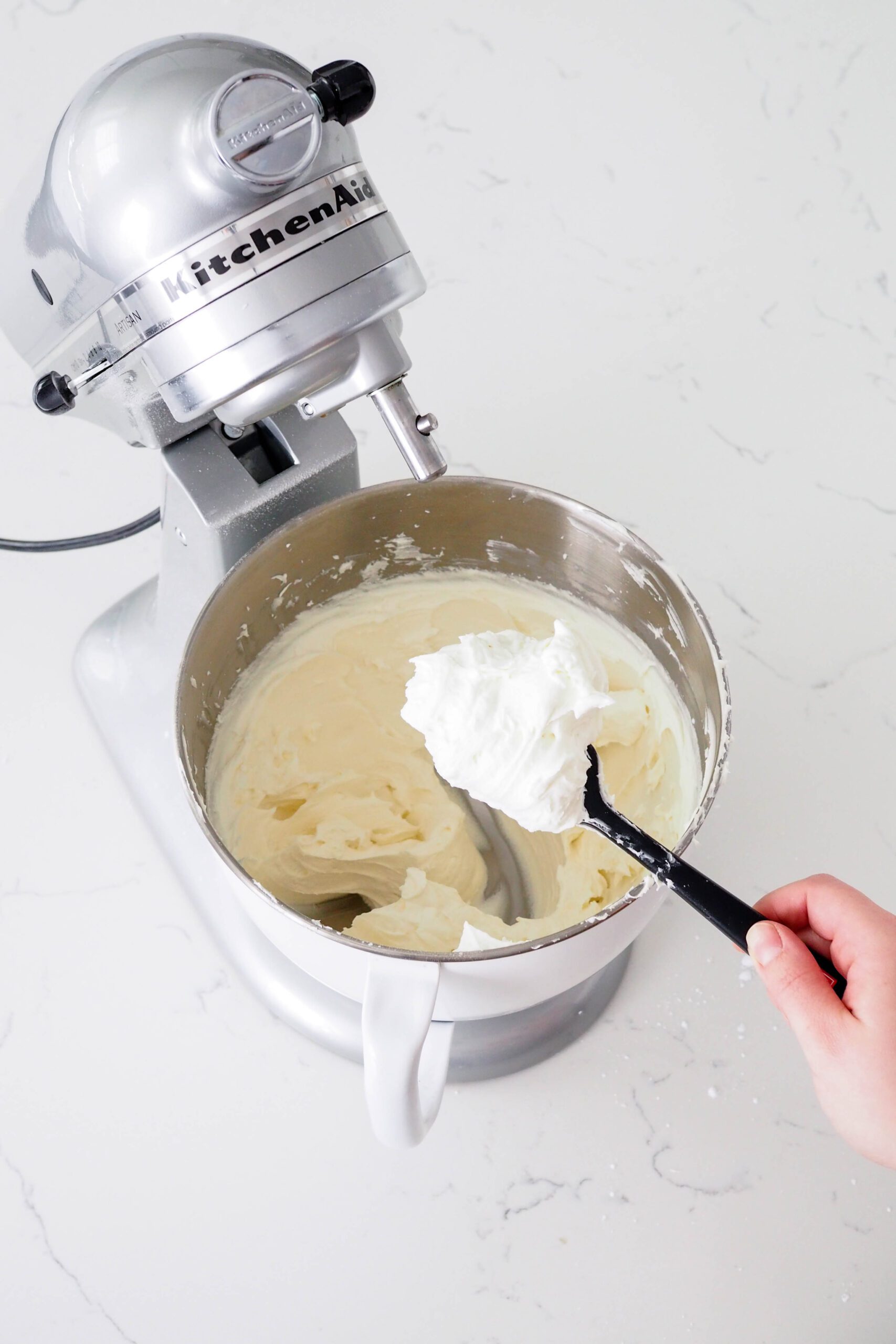
How to Assemble White Chocolate Pomegranate Layer Cake
Do not frost a partially-cooled cake. If running low on time, wrap a slightly warm cake in plastic wrap and put it in the fridge until it is fully chilled. Frosting and filling a warm cake will only result in goopy buttercream, a lack of structural integrity, and probably a few frustrated tears (speaking from experience!).
To layer your cake, place a dollop of white chocolate buttercream on a cake turner and firmly press a cake round onto it. Apply another dollop of buttercream and press a white cake layer onto it. Pipe a ring of buttercream around the layer, then spread it evenly across the top of the cake layer.
Then, pipe a ring of white chocolate buttercream around the edge to prevent the pomegranate filling from spilling out.
Spread half of the pomegranate jelly onto the cake layer in the center of the dam, then top with another cake layer, pressing lightly but firmly to seal it. Repeat.
Once your third layer is in place, spread a light coating of buttercream around the top and edges of the cake to seal in any crumbs. Refrigerate for at least 15 minutes, then frost with the remaining buttercream. Smooth with a bench scraper for perfect edges.
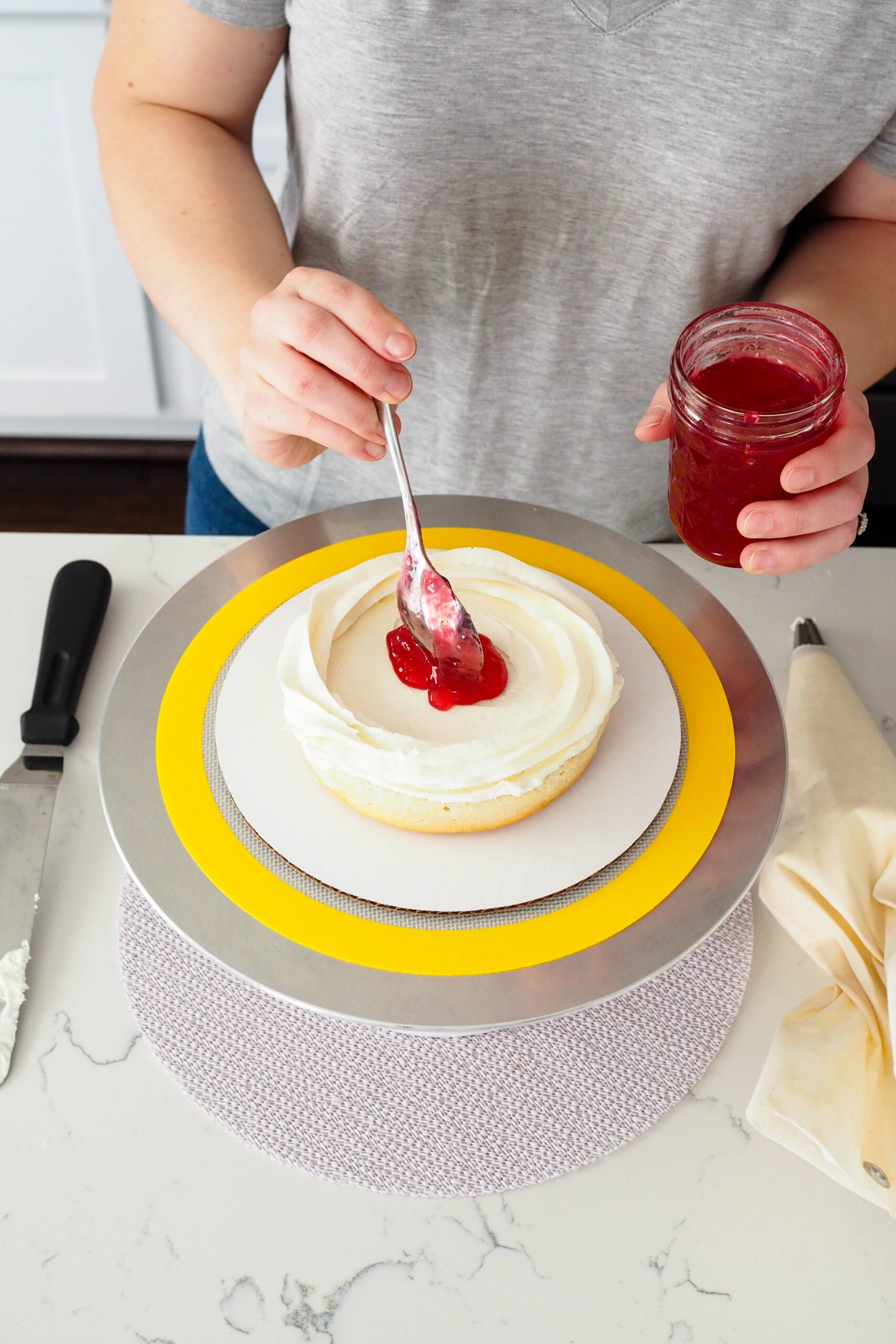
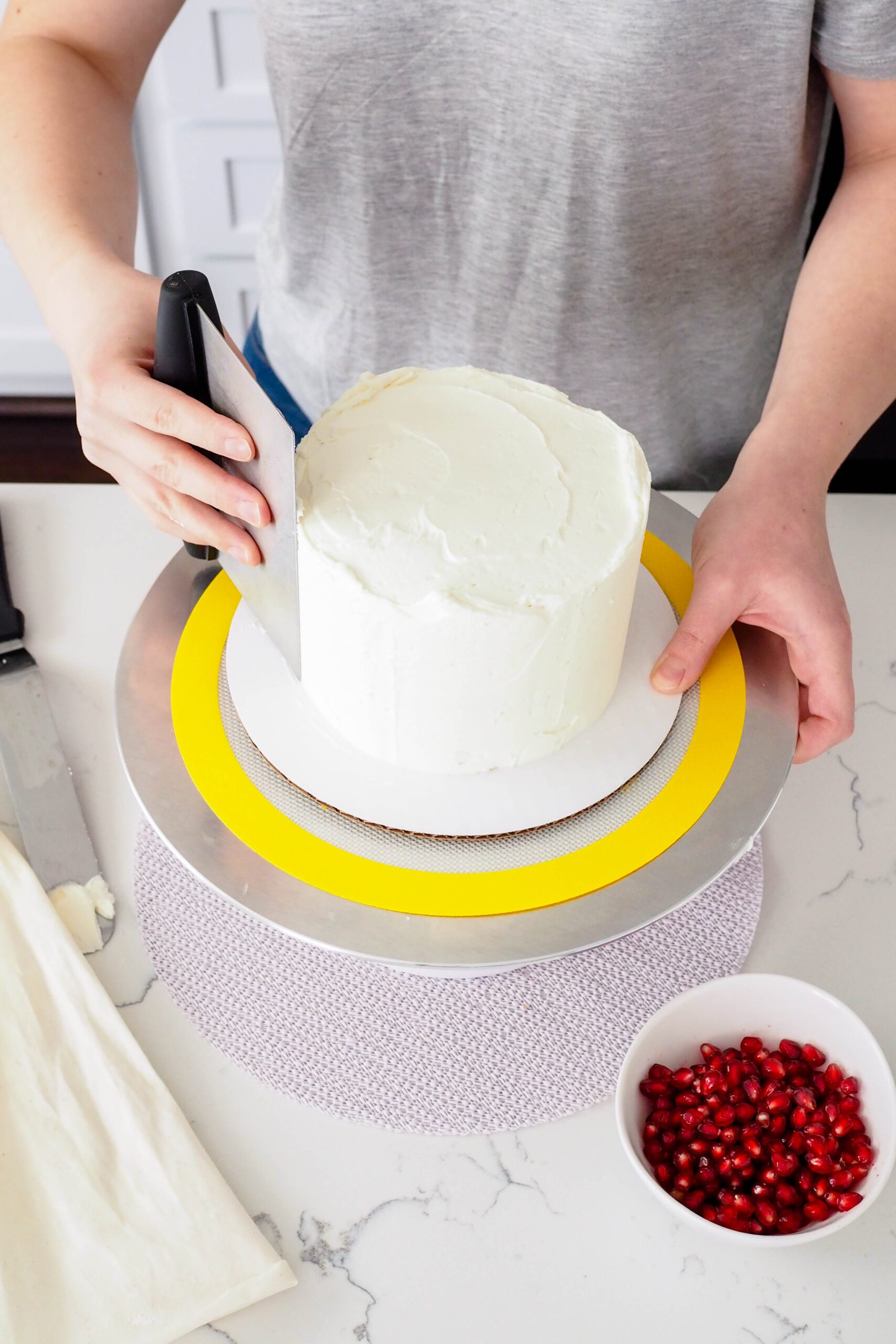
Once assembled, you can decorate the top with leftover buttercream. When I remade this cake in 2023 to update the images, I added a braided border and sprinkled pomegranate seeds on top. I think it added a lot to the final design!
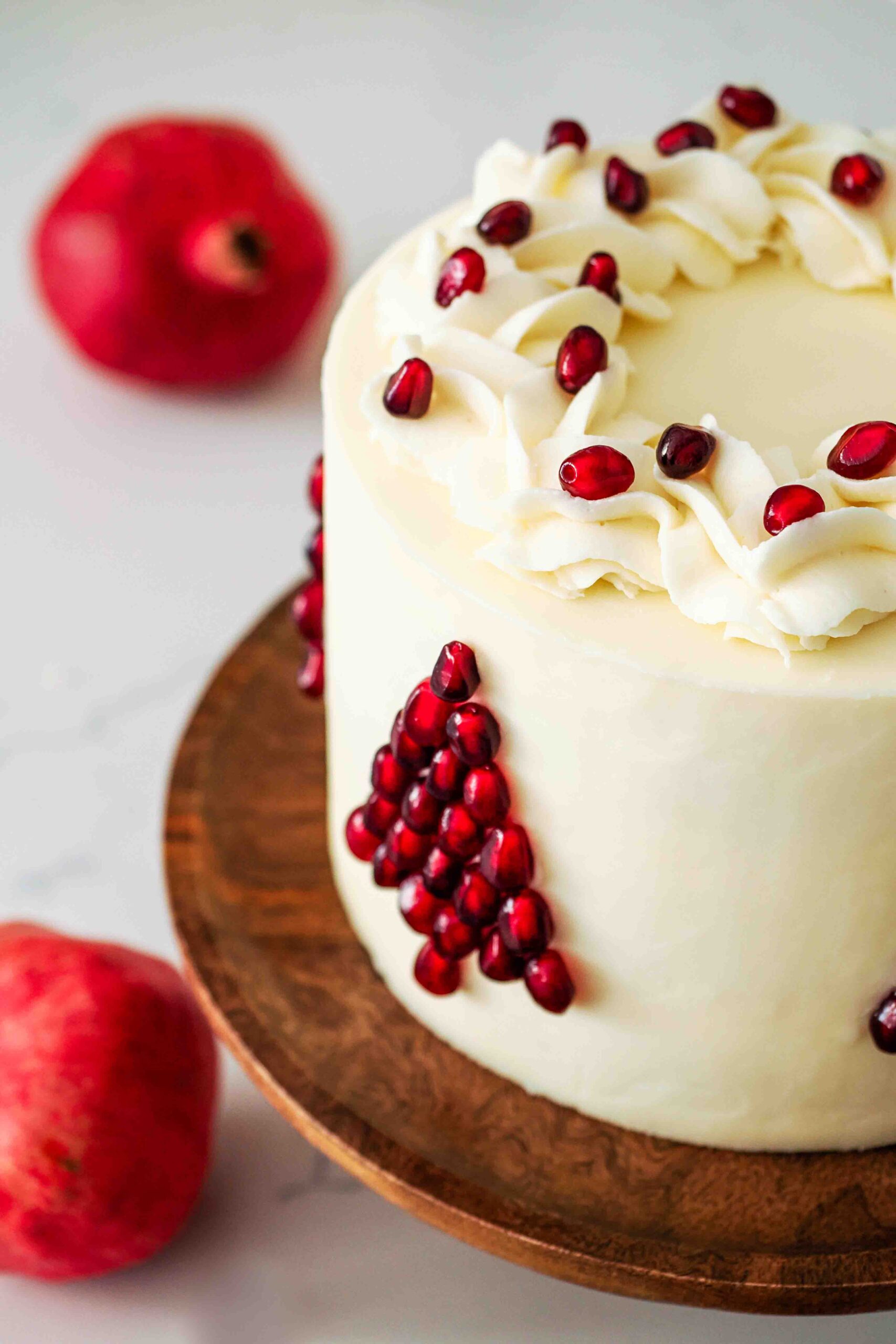
How to Make Christmas Tree Designs out of Pomegranate Seeds
If you look at pomegranate arils (seeds) closely, you’ll see that each one is shaped kind of like a teardrop. This shape and the natural variation in size makes for a beautiful pine tree made of pomegranate seeds that almost shimmers in the light.
To make a Christmas tree out of pomegranate seeds, place one pomegranate aril on the buttercream near the bottom of the cake. That will serve as the tree trunk. I started out using decorating tweezers but found it was much easier to place each aril by hand.
Next, add a row of pomegranate arils directly above the tree trunk. For larger trees, I used seven arils on this bottom row. The smallest tree I made had only four arils. Both were very cute!
Then, right above that row, add another line of pomegranate seeds above the gaps between the pomegranate arils. You’ll use one less aril per row this way to make a triangle.
Continue placing arils one at a time in each row, using one fewer aril with each row, until you make the top of the tree with just one aril.
You can also make these trees by working from the top down—whatever works for you!
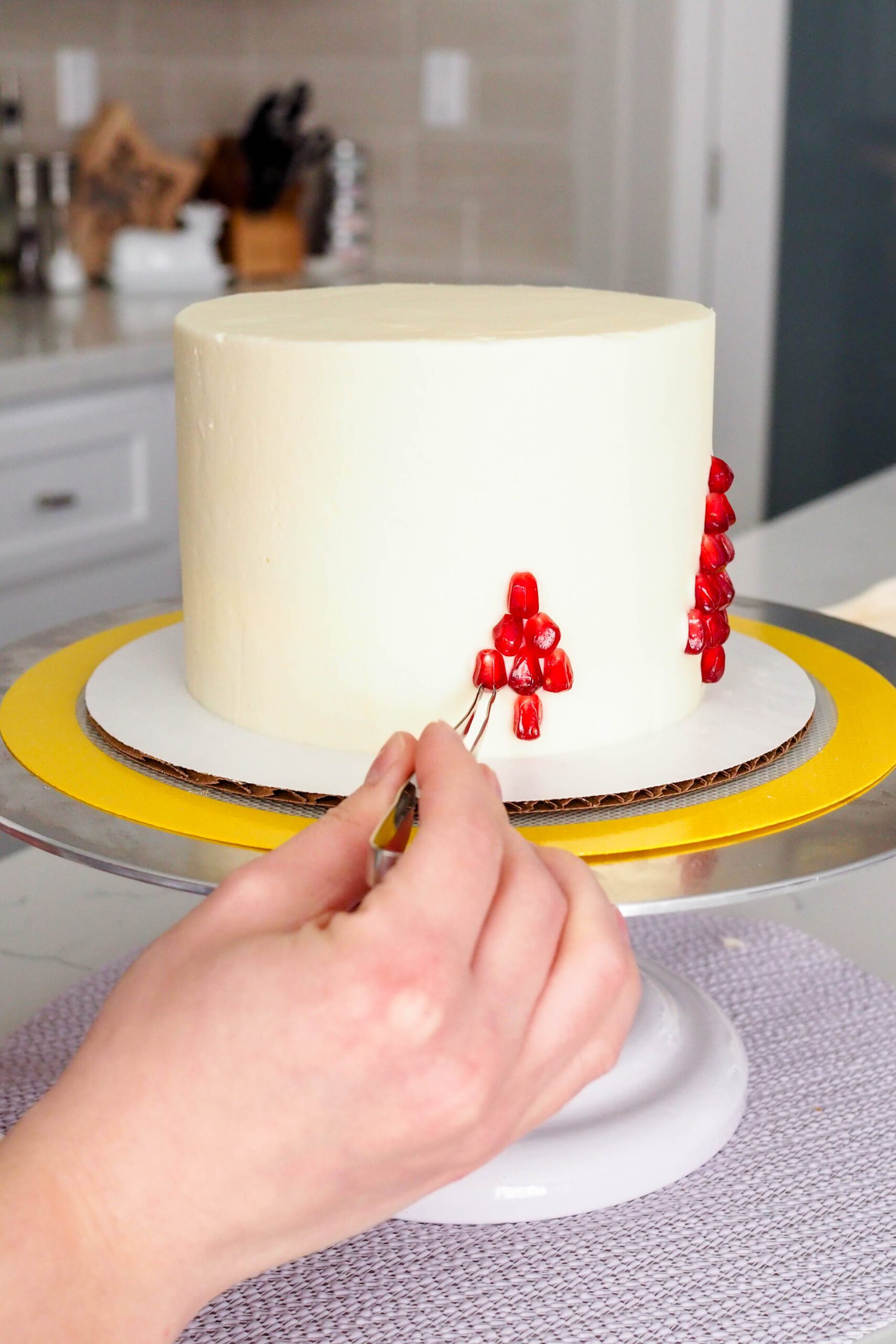
FAQs about White Chocolate Pomegranate Cake
Yes, I developed this recipe specifically because of how well pomegranate and white chocolate taste together! The tart pomegranate is paired perfectly with sweet white chocolate.
Yes, and it makes for a really good textural variety with the cake! I even sprinkle an extra handful of pomegranate seeds on top of my slice because I love the tartness and extra bite (and I usually suck the seeds dry before spitting them out when I eat them plain).
No, as long as the arils haven’t been broken open, the juice is fully sealed inside and will not bleed on the sides of the cake. I recommend rinsing the pomegranate arils once to get off any residual juice off before starting on the design for the cleanest look.
Yes, you can double all the ingredients in this recipe and make a three-layer 8″ cake if desired. The cakes will bake for a few more minutes than smaller ones, so adjust the baking time accordingly.
It sounds like your white chocolate may have seized because it got too hot or came into contact with water—this happened to me while I was testing the recipe! There’s not a good fix for this, so you’ll need to start over in a clean bowl and stir the chocolate every 15 seconds while melting it.
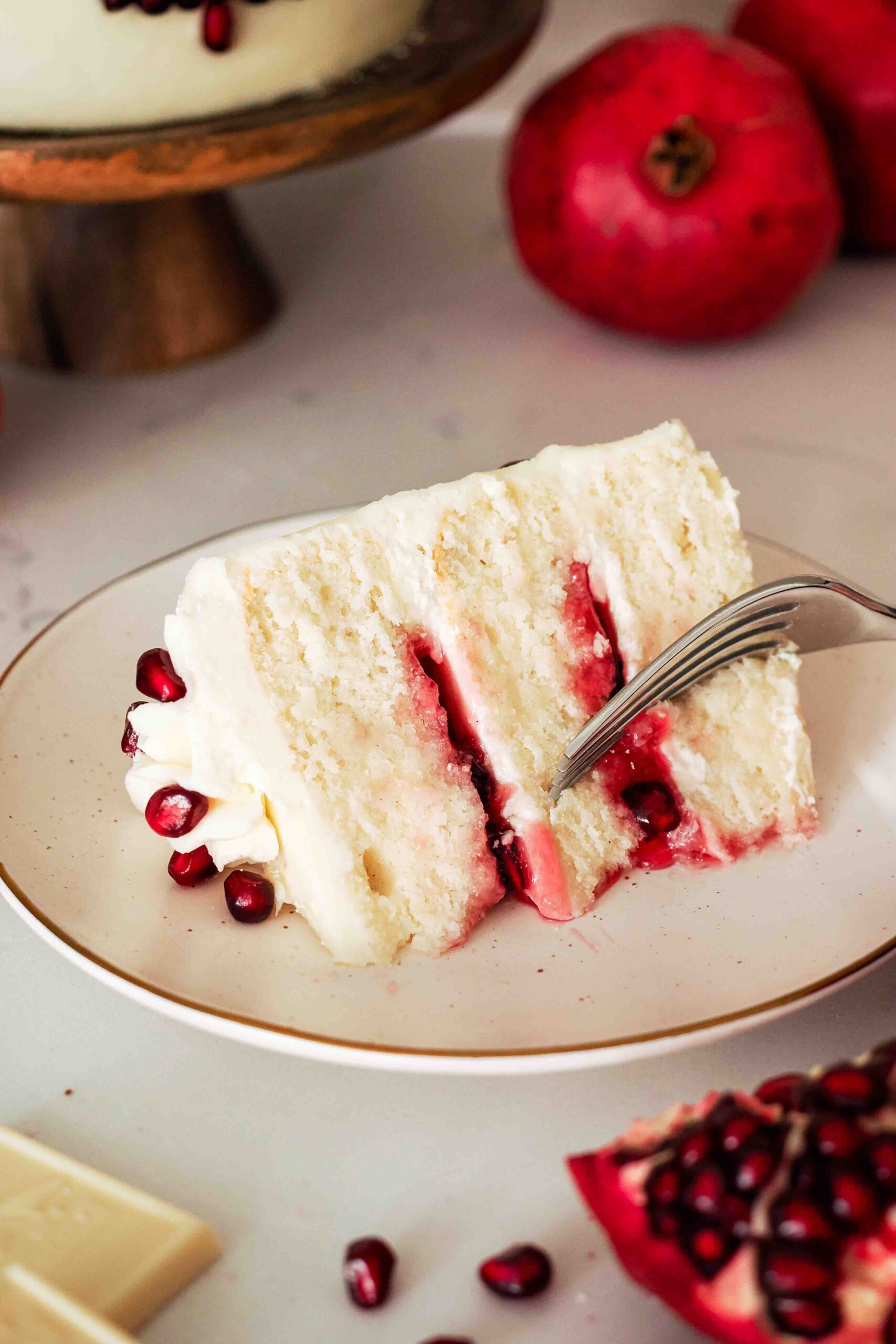
Dish Cleanup: Dish Mountain
I rate my recipe cleanups on a scale of 1 to 5. 1 is only a handful of dishes, and 5 is everything including the kitchen sink.
My white chocolate pomegranate layer cake recipe has a cleanup rating of a 5. This cake has fewer dishes than some of my other layer cakes, but it will still take you a while at the sink. To cut down on the dishes you have to use, I’d recommend lining your cooling racks with parchment paper and splitting up the bake into two days. I did the dishes for the cake one day and everything else the next.
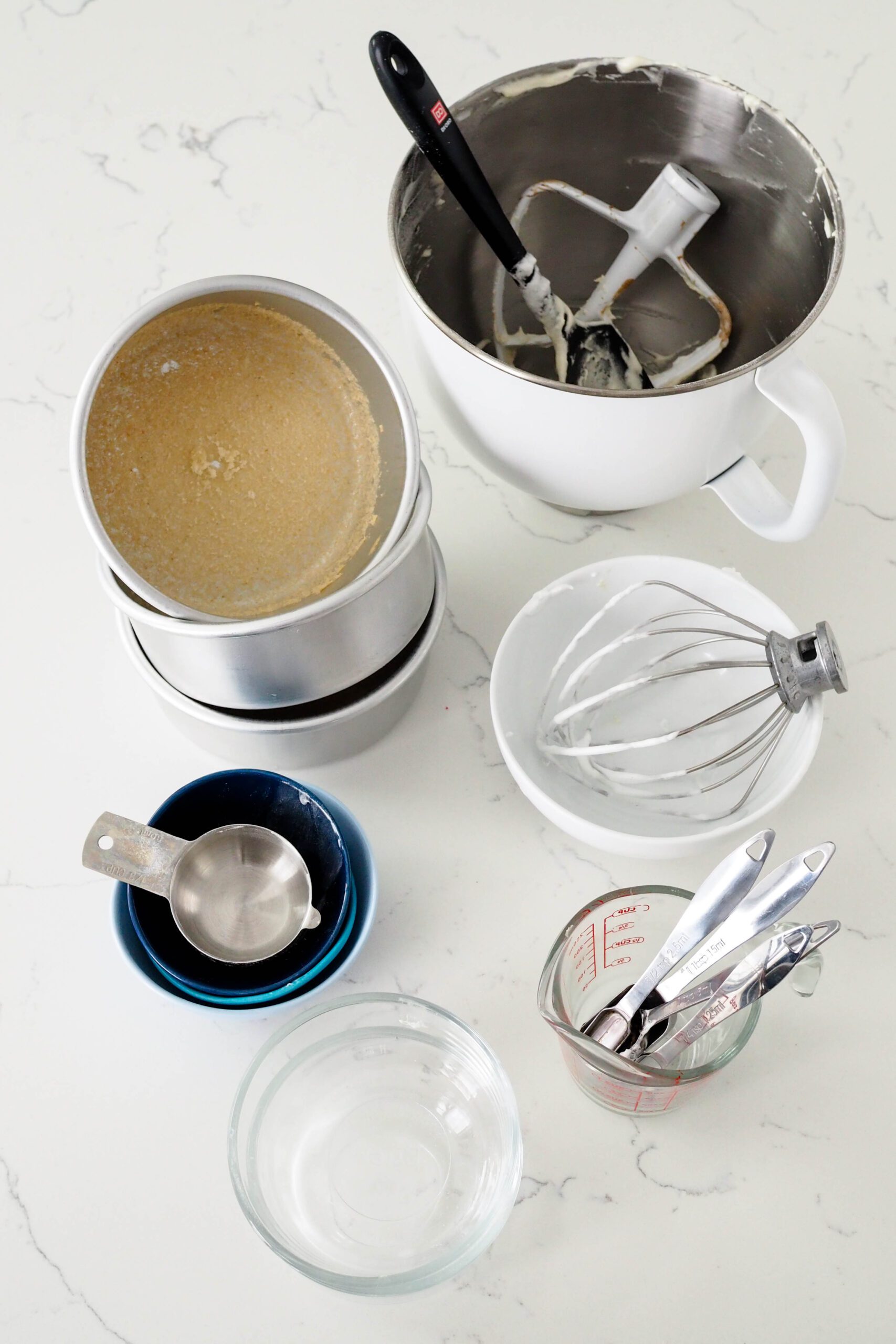
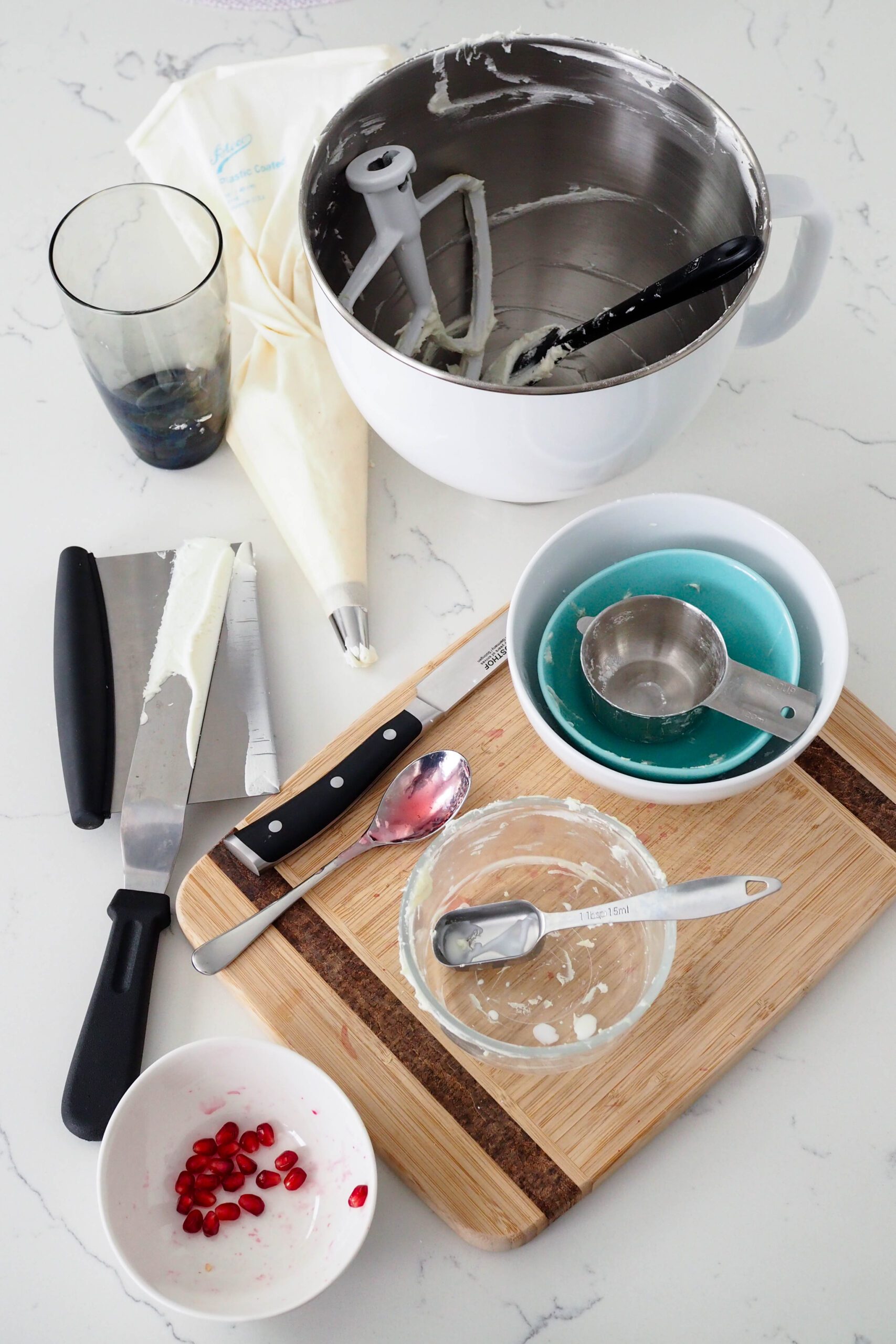
Other Recipes You May Enjoy
Pomegranate jelly isn’t often sold in stores, but it’s an easy jam to make at home. Make my pomegranate jelly as a small batch, or double (or triple) the ingredient quantities if you have a bounty of pomegranates.
Find more holiday recipes here on the blog, like these candy cane brownies made with peppermint extract and crushed candy canes.
I always have more layer cake inspiration coming your way. Try my apple snickerdoodle layer cake, the quintessential apple cinnamon layer cake for fall!
White Chocolate Pomegranate Layer Cake Recipe
White Chocolate Pomegranate Cake
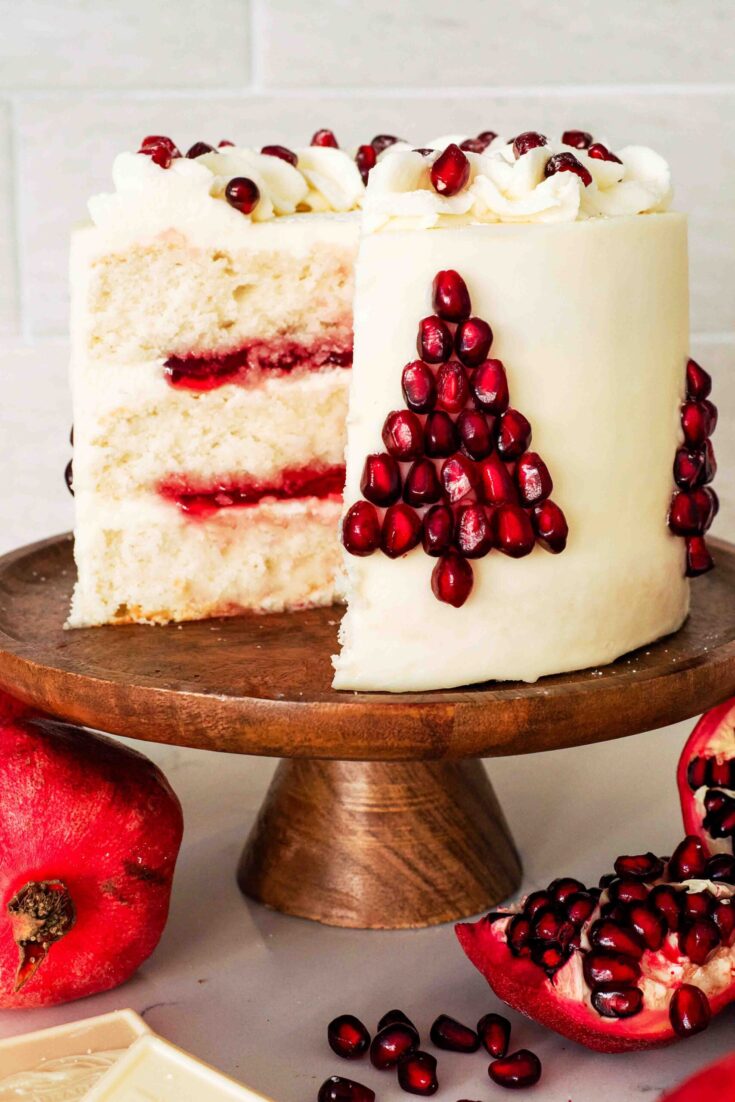
Tart pomegranate jam and sweet white chocolate buttercream are perfectly balanced between layers of light and fluffy white cake and decorated with pomegranate arils on the side.
Ingredients
For the White Cake
- 4 egg whites from eggs in the shell (not pasteurized)
- 1 cup granulated sugar, divided (200 g)
- 8 Tablespoons butter (113 g), at room temperature
- 1 ⅔ cups all-purpose flour (220 g)
- 1 ½ teaspoons baking powder (7 g)
- ¼ teaspoon salt (2 g)
- 1 Tablespoon neutral oil (15 ml)
- 1 teaspoon vanilla extract or vanilla bean paste (5 ml)
- ⅔ cup milk (160 ml)
For the White Chocolate Buttercream
- 1 cup white chocolate (170 g)
- 1 Tablespoon heavy cream (15 ml)
- 1 cup unsalted butter (226g), at room temperature
- 1 ¾ cups powdered sugar (about 200 g)
For the Pomegranate Filling and Decor
- ⅔ cup pomegranate jelly (160 ml)
- 1 cup pomegranate arils
Instructions
Making the White Cake
- Preheat the oven to 350°F/175°C. Line three 6" (15 cm) cake pans with parchment rounds, if desired. Set aside.
- In the bowl of a stand mixer fitted with the whisk attachment or a large bowl with an electric mixer, add four egg whites and mix on 2 (or low) until frothy, then increase speed to 4 (medium-low).
- When the whisk leaves a trail in the egg whites, sprinkle in only half of the sugar (½ cup), one Tablespoon at a time. Once incorporated, increase speed to 6 (medium) and whisk until soft peaks form, then transfer the meringue to a medium bowl and set aside. Wipe out your stand mixer bowl (or use another, if you have one).
- Place the remaining ½ cup of sugar, butter, flour, baking powder, and salt into your stand mixer bowl or another large bowl. Beat on low until the mixture looks sandy, with no large pieces of butter.
- To a small cup, add the canola oil, vanilla extract, and milk. Stream the liquid ingredients into the bowl with the mixer on low. Increase the speed to medium and beat until the batter is smooth but thick, about one minute.
- With a spatula, fold in the meringue by hand until no streaks remain, scraping down the sides and bottom thoroughly.
- Divide the cake batter evenly into the prepared pans and bake for 20-25 minutes, until the tops are a light golden brown and the center is firm.
- Place the cake pans on a wire rack and allow them to cool for about 20 minutes. When cooled, flip the pans upside down to release the cakes.
Making the White Chocolate Buttercream
- Melt the white chocolate in a heat-safe bowl over a double boiler or in the microwave in 15-second intervals, stirring after each, then set aside to cool slightly.
- In the bowl of a stand mixer or large bowl, beat unsalted butter on medium speed for one minute. Turn off the mixer, then add the powdered sugar about half a cup at a time. Mix after each addition until the powdered sugar is fully incorporated, then make a well in the center of the buttercream.
- When the white chocolate is only barely warm to the touch, pour the white chocolate into the well in the buttercream, taking care to avoid the edges of the bowl. Mix the white chocolate into the buttercream on low.
- Once incorporated, increase the mixer speed to medium and beat until the buttercream is light and fluffy, about 2-3 minutes. If needed, add a splash of heavy cream at a time to thin out the buttercream.
- Transfer to a piping bag and set aside.
Assembling the Cake
- Place a dollop of frosting in the center of a cake turner or stand, and then center a cooled cake layer on the stand.
- Pipe or spread an even layer of the white chocolate buttercream on top of the cake layer. Pipe a tall ring around the edge of the cake, like a dam.
- Spread half of the pomegranate jam evenly in the center of the cake layer, then place the next cake layer on top.
- Repeat steps 2 and 3 for the second layer.
- Place the final cake layer on top, and press firmly to seal the edges. Use an offset spatula to smooth a thin layer of the white chocolate buttercream onto the edges and top of the cake to seal in crumbs. Chill for at least 15 minutes.
- Once the buttercream has hardened, frost with the remaining buttercream. Use a scraper or offset spatula to smooth the sides, scraping the excess back into the mixer bowl. For ruler-straight edges, chill for an additional half hour or until hardened, then smooth with a bench scraper.
- Decorate as desired. I piped a braided border on the top and sprinkled with pomegranate arils, and then made a forest of pomegranate seed Christmas trees on the sides.
- Chill for at least an hour before serving to keep the jelly in the center thick and prevent it from spilling out.
Notes
Store the cake in an airtight container for up to four days in the fridge.
Recommended Products
As an Amazon Associate and member of other affiliate programs, I earn from qualifying purchases.
Nutrition Information:
Yield:
10Serving Size:
1Amount Per Serving: Calories: 652Total Fat: 36gSaturated Fat: 21gTrans Fat: 0gUnsaturated Fat: 12gCholesterol: 98mgSodium: 257mgCarbohydrates: 77gFiber: 2gSugar: 55gProtein: 7g
The nutrition facts are estimated and may vary based on specific ingredients used.
Thanks for making my white chocolate pomegranate cake!
If you liked it, please rate this recipe five stars so others find it, too.
I’d love to see how your pomegranate Christmas tree cake turns out: Take a photo and tag me on Instagram @floralapronblog to share with me, or use the hashtag #floralapronbakes.

